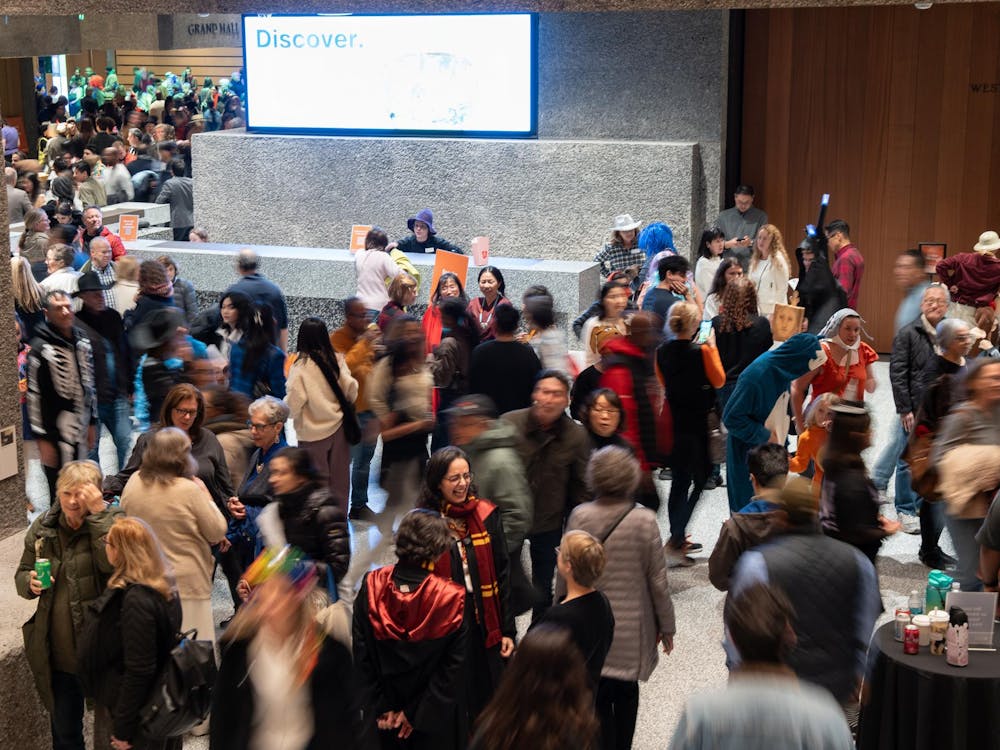The Princeton University Art Museum’s Modern and Contemporary Art Pavilion, curated by Alexandra Foradas, spans textures, mediums, and styles, with the viewer seeing a new juxtaposition of pieces no matter where they stand.
The pavilion starts strong with Jean-Michel Basquiat’s “Notary” (1983) at the entryway. In this piece, and many of his others, Basquiat does not erase his work, instead letting the viewer in on his creative process. He crosses out words or letters just to later rewrite them, blurring the lines between draft and final product.
The pavilion’s walls do not reach the ceiling, lending an openness to the walk and encouraging viewers to look out across the gallery, where they will be greeted by a lively horizon at nearly any angle. In many places, it is possible to look through doorways to see large slices of the gallery, hosting a collection of radically different and curious pieces that draw you further in.
The collection boasts another Basquiat, a Yayoi Kusama painting, and multiple Willem de Kooning works. Further into the exhibit, different textures permeate the walls in a simple yet striking way. A frameless canvas with crumpled paper, glitter, sequins, and strings covered in acrylic paint — an untitled piece by Howardena Doreen Pindell (1977) — provides a range of textures in a contemporary medium.
Pindell was ahead of her time — much of her art is similar to contemporary works. She used a hole punch to draw the viewer’s eye to specific points of light and color, according to the piece’s didactic. More typical works from the 1970s might include Andy Warhol’s bold striking prints and colors, but Pindell subverts this preconception with its simplistic and “undone” characteristics.
Foradas’s predecessor, Kelly Baum, started the curation for the pavilion, prioritizing the way pieces interact when choosing artworks and positions.
“My predecessor and colleagues chose and juxtaposed objects in ways that encourage the viewer to consider the impact of cultural contact and exchange,” Foradas wrote to The Daily Princetonian.
Whether steeped in meaning or entirely meaningless, the art in the pavilion has been organized to foster curiosity and inspire.
The gallery juxtaposes Sanford Bigger’s “Tunic” (2003), a feathered puffer coat, with Elias Sime’s “TIGHTROPE: ECHO?!” a rectangular sculpture made of reclaimed electrical wire and components. The aesthetic contrast of these two pieces in such proximity reminds the viewer of how conventional artistic boundaries are broken by contemporary artists. The sharpness of “TIGHTROPE: ECHO?!” stands out against the colored feathers of Bigger’s work.
Perhaps the most charming part of the pavilion is the Hans & Donna Sternberg Viewing Room attached in the northeastern-most corner of the art museum. There, the viewer leaves the layered views of textured contemporary art and finds a single work: Jane Irish’s “Cosmos Beyond Atrocity” (2024), embedded in the ceiling.
The captivating piece was commissioned for this specific room of the art museum, making for a cohesive viewing experience. While a mesmerizing distortion of angles and pastel colors warp the viewer’s perspective, an arm emerges from the sky and reaches towards them.
“The Museum was keen to work with a regionally based artist committed to the continuing vitality of painting; we were thrilled that Jane was so keen to mine the collections for inspiration and to draw on the past,” Museum Director James Steward said in a statement.

The new viewing room was adapted in modern style from a similar room in the old art museum.
“The other viewing room felt a little bit more like a living space with a restful feeling,” said Princeton resident Matthew Feuer. “[The new viewing room] is more integrated into the museum.”
However, Feuer noted that there were clear resemblances between the two: both featured identical circular windows and were surrounded by trees, including the dawn redwood marking the eastern-most point the new museum reaches. Feuer also noted that the old room didn’t have any art — it was only a domestic escape from the rest of the museum.
“[The old room] was charming, but it was nothing like this,” Feuer said.
The new Sternberg Viewing Room coaxes the viewer into meditation, providing a haven of natural and artistic surroundings.
The pavilion as a whole will be ever-changing, as the museum will periodically update the modern art displayed. Foradas has spoken with students and professors alike to gauge what the Princeton community looks for in contemporary art.
“A few key themes emerge: landscapes and borders, activism and liberation, ways of (hi)storytelling, questioning abstraction, and the relationship between art and performance and other types of liveness,” according to Foradas.
In the meantime, there is much art in which to indulge. This pavilion is sure to have something grab your attention, either with an eye-opening piece or a striking view across many.
Lulu Mangriotis is a News contributor for the ‘Prince.’ She is from New York City.
Please send any corrections to corrections[at]dailyprincetonian.com.








